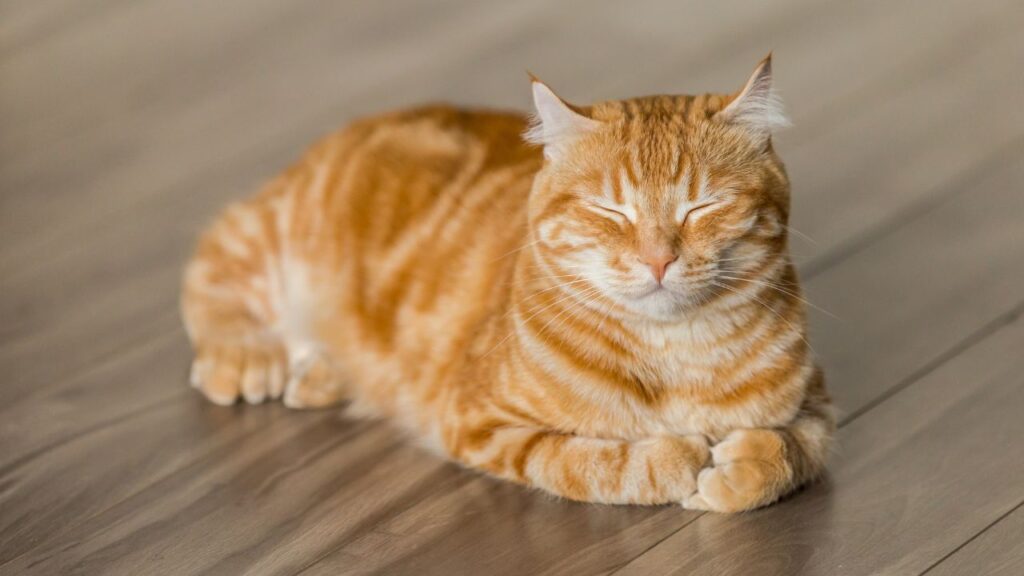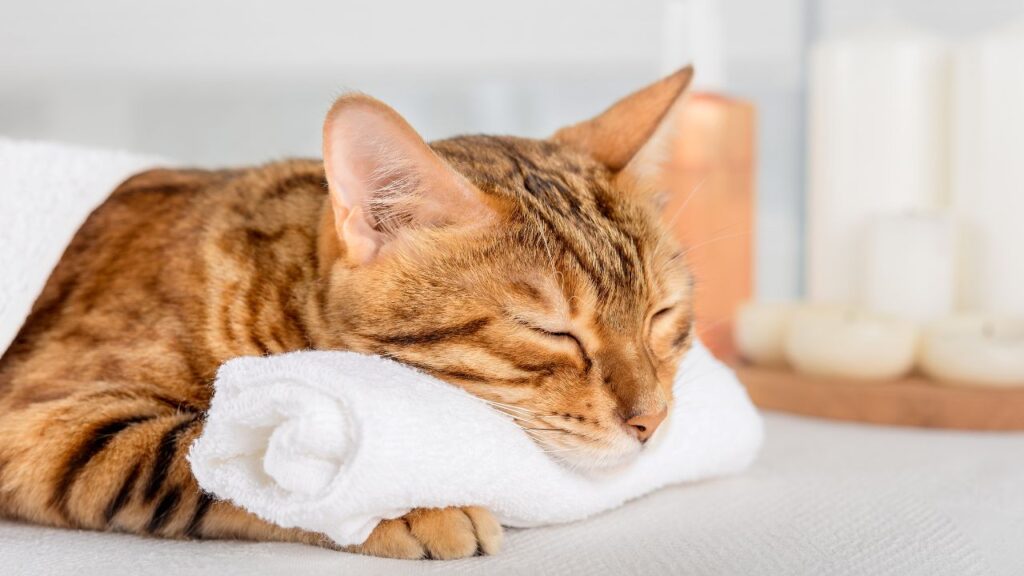Have you ever wondered what your cat is really trying to tell you? Understanding cat body language can transform your relationship with your furry friend, making interactions smoother and more meaningful. Whether you’re a new cat parent or a seasoned feline enthusiast, this guide addresses the most common questions about cat body language, helping you interpret your cat’s silent communications with ease.
1. What Do a Cat’s Tail Movements Mean?
A cat’s tail is a powerful tool for communication, conveying a range of emotions and intentions.
- Upright Tail with a Curve: Often signifies a friendly greeting. If your cat approaches you with its tail held high and slightly curved, it’s saying hello and feeling confident.
- Puffed-Up Tail: Indicates fear or aggression. When a cat feels threatened, it may puff up its tail to appear larger and more intimidating.
- Twitching or Thumping Tail: Can signal irritation or excitement. A tail that flicks rapidly might mean your cat is annoyed, while gentle thumping could indicate playful energy.
Actionable Tip: Pay attention to your cat’s tail position and movement in different situations to better understand their mood and respond appropriately.
Visual Suggestion: An infographic illustrating various tail positions and their meanings.
2. How Can I Tell If My Cat Is Relaxed or Stressed?
Recognizing the signs of relaxation versus stress in your cat can help you create a comfortable environment.
- Relaxed Signs:
- Loose, soft body posture.
- Slow blinking or gentle eye contact.
- Purring softly.
- Stressed Signs:
- Hunched back or tucked tail.
- Flattened ears.
- Rapid breathing or hissing.
Expert Insight: Dr. Jane Smith, a feline behaviorist, recommends creating safe spaces where your cat can retreat and feel secure, reducing stress-related behaviors.
Visual Suggestion: Side-by-side images of a relaxed cat versus a stressed cat highlighting body posture differences.
3. What Does It Mean When a Cat Kneads?
Kneading is a common behavior where cats press their paws against a soft surface, often alternating between left and right.
- Origins of Kneading:
- Kittenhood: Kittens knead their mother’s belly to stimulate milk flow.
- Comfort: Adult cats knead to mark territory with scent glands in their paws and to create a comfortable resting spot.
Personal Anecdote: My cat Luna kneads her blanket every evening before settling down, a comforting ritual that mirrors her kitten days.
Visual Suggestion: A short video clip showing a cat kneading to illustrate the behavior.

4. How Do Cats Use Their Eyes to Communicate?
A cat’s eyes are a window to their emotions and intentions.
- Slow Blinking: Signifies trust and affection. If your cat slowly blinks at you, try reciprocating to strengthen your bond.
- Wide Eyes with Dilated Pupils: Can indicate fear, excitement, or overstimulation. Observing the context helps interpret the exact emotion.
- Direct Stare: May be a sign of dominance or aggression. It’s best to avoid prolonged eye contact to prevent escalating tension.
Actionable Tip: Use slow blinking as a way to communicate calm and friendly intentions with your cat.
Visual Suggestion: Diagram showing different eye shapes and pupil sizes associated with various emotions.
5. What Does It Mean When a Cat’s Ears Are Forward, Backward, or Flattened?
A cat’s ear position provides significant clues about their current state.
- Forward Ears: Indicate curiosity or attentiveness. Your cat is likely interested in something in their environment.
- Backward or Flattened Ears: Signal fear, aggression, or irritation. This defensive posture helps protect their ears and head.
- Swiveling Ears: Show that your cat is listening intently to multiple sounds around them.
Expert Insight: Dr. Emily Brown emphasizes that ear positions, combined with other body language cues, offer a comprehensive understanding of your cat’s emotions.
Visual Suggestion: An image collage showing a cat with ears in different positions.
6. How Does a Cat’s Body Posture Reflect Their Mood?
Body posture is a comprehensive indicator of a cat’s overall mood and comfort level.
- Arched Back with Puffed Fur: Often a defensive stance, indicating fear or readiness to fight.
- Crouched Body with Hidden Head: Signifies extreme fear or submission.
- Relaxed and Loose Posture: Reflects contentment and trust in their environment.
Actionable Tip: Observe your cat’s overall body posture in various situations to gauge their emotional state and respond with appropriate care.
Visual Suggestion: Comparative images of different body postures and their emotional meanings.
7. What Is the Significance of a Cat’s Purring?
While purring is often associated with contentment, its meaning can vary.
- Contentment: A gentle purr usually indicates that your cat is happy and comfortable.
- Self-Soothing: Cats may purr when they are in pain or stressed as a way to calm themselves.
- Communication: Kittens purr to communicate with their mother, and adult cats may use purring to signal their presence or needs.
Personal Anecdote: My cat always purrs loudly when she’s ready for her favorite treats, a clear sign she’s happy and anticipating something good.
Visual Suggestion: A close-up image of a cat purring, highlighting the relaxed facial muscles.

8. Why Do Cats Sometimes Roll Over?
Rolling over is a multifaceted behavior with different interpretations.
- Trust and Vulnerability: When a cat rolls onto their back, it signifies trust and relaxation, exposing their belly, a vulnerable area.
- Playfulness: A cat might roll over to initiate play, inviting you to engage with them.
- Defensive Posture: In some cases, rolling onto the back can be a defensive move, preparing to defend themselves if threatened.
Actionable Tip: Consider the context and accompanying body language to accurately interpret why your cat is rolling over.
Visual Suggestion: Series of images showing a cat rolling over in different contexts (e.g., for a belly rub vs. defensive posture).
9. How Do Whiskers Indicate a Cat’s Feelings?
Whiskers are highly sensitive and serve as tactile tools, but they also convey emotional states.
- Forward-Facing Whiskers: Show interest and curiosity. Your cat is likely exploring or intrigued by something.
- Relaxed Whiskers: Indicate a calm and content state.
- Whiskers Pulled Back: Signify fear, aggression, or discomfort.
Expert Insight: Dr. Laura Green notes that whisker position, combined with other body language cues, provides a nuanced understanding of a cat’s emotions.
Visual Suggestion: Macro shots of a cat’s face highlighting different whisker positions.
10. What Does It Mean When a Cat Hides or Avoids Interaction?
Hiding or avoiding interaction can be a sign of various emotions or needs.
- Stress or Fear: Your cat may hide when feeling threatened or stressed by changes in the environment.
- Illness or Pain: If a usually social cat starts hiding, it could indicate that they’re unwell.
- Needing Space: Sometimes, cats simply need alone time to recharge and may seek solitude without any underlying issues.
Actionable Tip: Monitor the frequency and context of hiding behavior. If it becomes persistent, consider consulting a veterinarian to rule out health issues.
Visual Suggestion: Image of a cat in a cozy hiding spot, emphasizing the need for safe spaces.
Conclusion: Building a Deeper Connection with Your Cat with Understanding Cat Body Language
Understanding cat body language opens the door to a more harmonious and fulfilling relationship with your feline friend. By recognizing and interpreting these subtle signals, you can better respond to your cat’s needs, ensuring their happiness and well-being.
Call to Action: Ready to become a cat body language expert? Subscribe to our newsletter for more tips and insights, download our free guide on feline behavior, or share your experiences in the comments below. Let’s continue the conversation and strengthen the bond with our beloved cats together!
Enhance Your Blog with Visuals:
- Infographics: Create easy-to-read infographics summarizing key body language signs.
- Videos: Include short clips demonstrating different cat behaviors.
- Images: Use high-quality images showing various cat postures and expressions to complement each section.
By incorporating these visuals, readers can better visualize and understand the concepts discussed, making the information more engaging and memorable.

